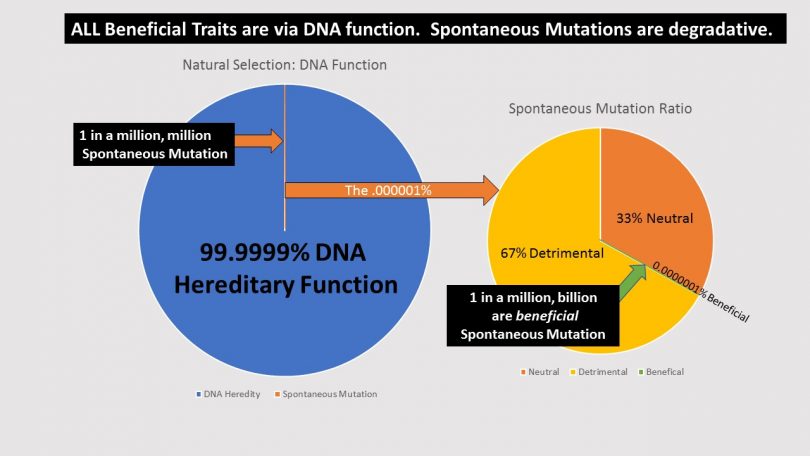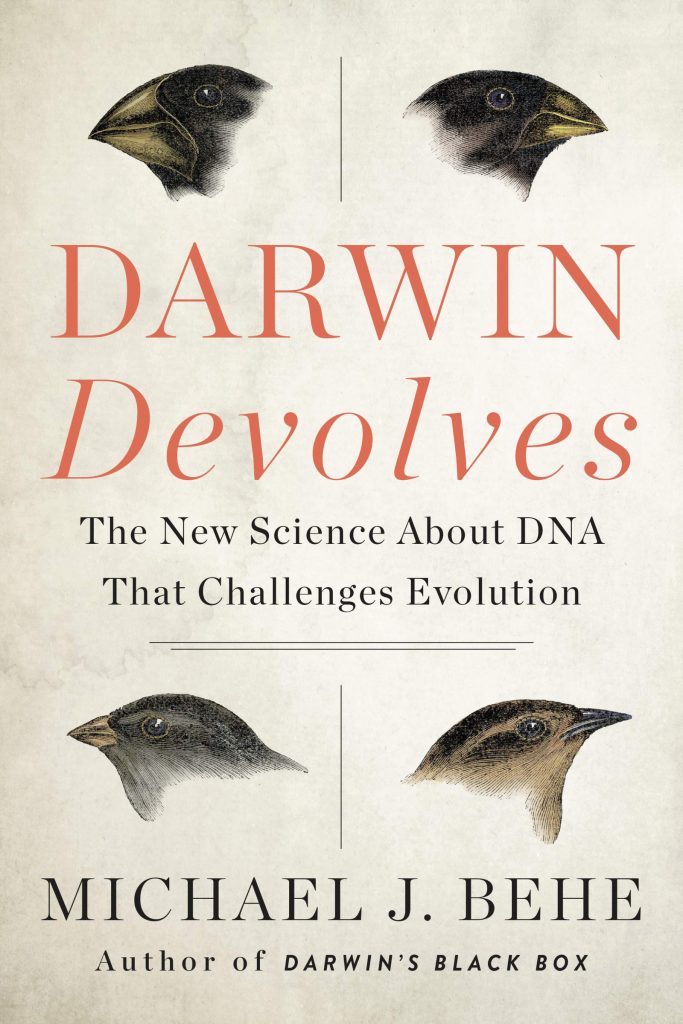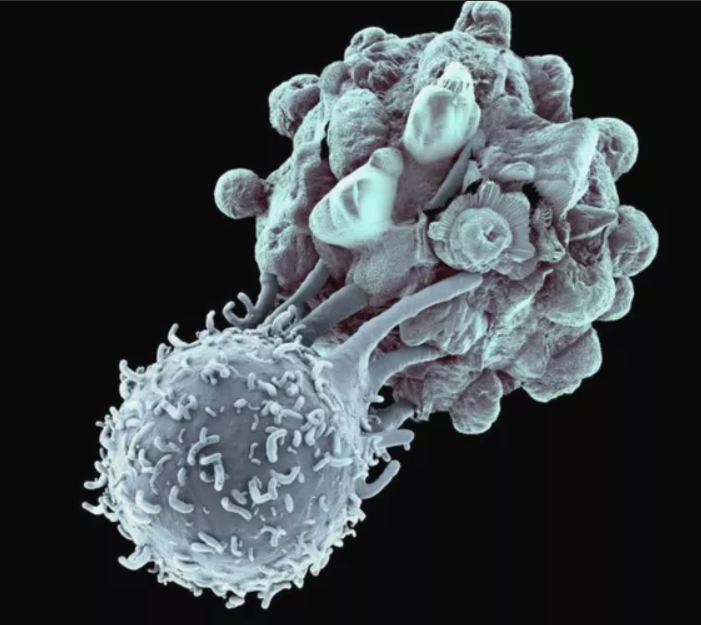The term evolution has a massive scope, transcending into nearly all fields of science, pop culture, and even science fiction. Many argue that we must keep scientific explorations separate (such as: origin of matter, galaxy formation, emergence of life, etc.), but we struggle to keep the areas divided because evolution is used to explain everything. Evolution is used to define the origin of matter at the Big Bang, natural processes that formed the universe, and even the chemical processes which are believed to caused life to emerge on earth.
Considering that the term evolution is so enormously far reaching we find it as an all-inclusive term which means at its core: everything that has happened, happened only by and because of a strict natural process. Therefore, evolution prohibits explanations (beyond them being delusion) which include purpose, design, intelligence, volition, beauty, God, or even a mind because the mechanism of change is pure spontaneous chance.
For our purposes here, we need to narrow down the term evolution as to specifically apply to biology. In biology we find that the term still broadly means “change”. Of course, no sane person denies that there are “changes” in life forms, we all witness this in the world around us. If you have had a child, you see it in the face of your offspring. Therefore, if we stop here at “change” being evolution then, yes, evolution is true. Case closed! No, not even close.
The claim of the mechanism of evolution is much, much bigger. Evolution is relied upon to be the mechanism that caused and causes all the variety and complexity of life. Now, this is quite the test for the theory to prove or at least provide some evidence because observing change is one thing, but, proving the mechanism is quite another.
There are two primary terms used to describe these changes: Natural Selection and Random Mutation.
Darwinian evolution explains the mechanism for evolution (the mechanism for “biological change”) occurs through these two broad biological processes. Again, in light of the massive reach of the term evolution, there are many other terms (also often used interchangeably) within biological evolution but they are the results of Natural Selection and Random Mutation.
Such descriptive terms include: genetic drift, gene-flow, bottle-necking, adaptation, reproductive isolation, gradualism, speciation, selective breeding (natural or artificial), survival of the fittest, and others. We repeat to clarify, such descriptive terms are explanations of populations which are the results due to the mechanisms of Natural Selection and Random Mutation.
Therefore, the proverbial “hands” of evolution, coined as the “blind watchmaker” by Richard Dawkins, are the mechanisms of Natural Selection and Random Mutation.
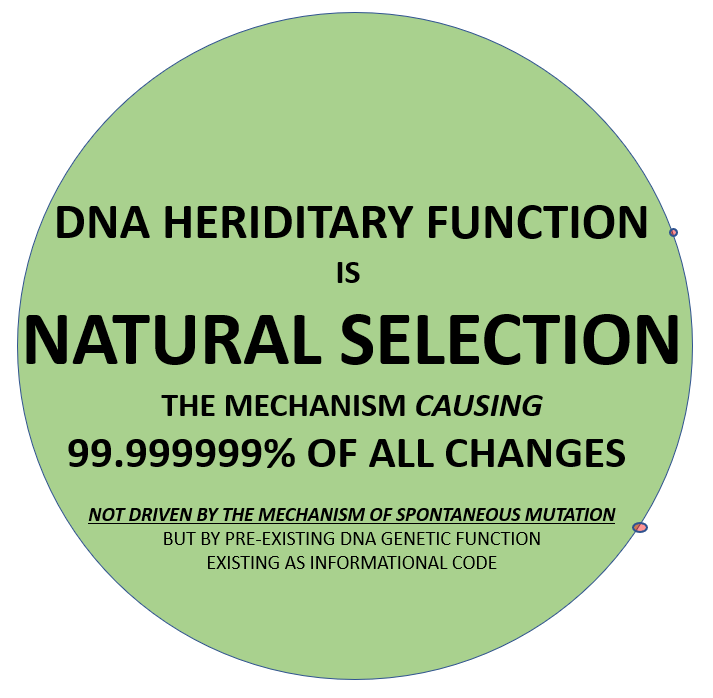
Therefore, we focus the definition of biological evolution as: “Natural Selection and Spontaneous Mutations are the mechanism evolution uses to change living organisms.”
Let’s examine Natural Selection and Spontaneous Mutations separately. Natural Selection, bearing in mind many terms are used interchangeably in any discussion of evolution, refers to the hereditary function of DNA. Natural Selection can be defined as the preexisting DNA code which instructs changes which are today are known to occur at the genetic level.
It is paramount to recognize that during reproduction DNA does not incur Spontaneous Mutations- sex cell “germ line mutations” are preexisting in the DNA code.
Genetic variability observed are the result of DNA function which is also called Natural Selection. Such genetic variation at reproduction, is both allowable and limited by preexisting DNA function.
The DNA alleles allow and limit the new formation of genes (generated from the parents genetic material) during reproduction as the zygote is formed. A zygote is a fertilized ovum. Naturalism calls this process a “germinal mutation in the germ line“ which we largely dispute the word “mutation” being used here. However, we recognize that to the naturalist such a term appears to stand as support for the expected spontaneous and random processes of evolution. Despite the fact that this process is neither spontaneous or random. To clarify, “germinal mutation in the germ line” must not be confused with spontaneous mutations are polar opposites: Germinal mutation occurs due to DNA function and information which Spontaneous Mutations occur willy-nilly. During reproduction, changes occur as an intended process driven by the mechanism of Natural Selection (DNA); Spontaneous mutations are just that– spontaneous. They are essentially errors which occur during DNA duplication not during reproduction. Such spontaneous mutations cannot occur until after the zygote is formed and DNA begins to duplicate.
Reproductive mutations exist only in the sex cells (“germ line”) for any mutation to be passed to the next generation. As a side note, this is the only place evolution or change of any kind could occur. As an example of a reproductive mutation: if close relatives who share common germ line mutations reproduced, then the offspring would very likely emphasize such germ line mutations. Therefore, the offspring would have an increased likelihood of encountering various genetic problems including perhaps physical deformations, cancers, or a reduced mental capacity.
In a nutshell, Natural Selection is the mechanism that drives observable change in offspring due to intended hereditary function from preexisting DNA.
As we found, after conception spontaneous mutations begin to occur. Studies have shown that a great many are neutral, most are detrimental, and as we shall discuss a rare few beneficial.2 These spontaneous mutations are called somatic mutations which are due to duplication errors during DNA transcription.2
Such spontaneous mutations are literally mistakes which occur (due to spontaneous random chance or environmental hazards) on the genetic material. Such an error, and really no error as we shall discover, was ever intended to have occurred during any replication process. It only happens as mistake– never intended. Such spontaneous mutations were found at John Hopkins to account for 2/3 of all cancers in humans.3
As we discussed, after conception, the second mechanism which evolution relies on to move evolution is Spontaneous Random Mutation. We discovered that during Natural Selection only sex cell mutations impact the offspring which is in preexisting genetic material provided by the parents. We find such changes are great for diversity within the same species. Changes such as hair, eye, or skin color. Natural Selection (DNA function) drives all the multitude of attributes which impact living organisms within the same species.
Darwinian theory relies on unguided, random, spontaneous mutations causing genetic variation followed by repeated rounds of such molecular changes occurring over millions of years. Together, Spontaneous Mutations account for the coherent complex functional features within cellular life. Darwinism makes itself committed heavily toward the mechanistic philosophy that such random spontaneous “errors” slowly cause the decent of species from “simple” to complex. But can spontaneous “errors” really be the mechanism for the elegance of life?
Note: for our purposes here, we are not exploring the origin of life, which of course is a precursor to life existing anywhere, to examine Spontaneous Mutations we assume life (somehow) already emerged.
Can such undirected Spontaneous Mutation provide the mechanism to change animal classification species upward into a new genus? A new family to a new order? To a new class, new phylum, and a new kingdom? Either way, can Spontaneous Mutation account for the decent of all living things, from simple to complex, from fungus to man? Can it account for all the known diversity and complexity with a mere 0.0000001% of change driven by Spontaneous Mutation? The answer genetic research shows to the above questions is a resounding: No, not even close!
The amazing power of evolution to create all life has been exalted by the media, NASA, Discovery Channel, History Channels, Science programming, Hollywood Movies, textbooks, teachers, and professors all around the world. They point to the amazing power of evolution in nature as the mechanism for such jaw dropping complexity. These outlets mix in the terms we have discussed such as Natural Selection and Spontaneous Mutations as beneficial components of change. These outlets seldom (if ever) use the real terms which actually describe Spontaneous Mutations. Terms such as degrading, damaging, deleting, limiting, deadly, cancerous, or detrimental. They neglect the mountain of data which reports that in the rare cases of “beneficial mutation” it occurs only at a genetic expense as a loss of material.1
Therefore, any “evolved” species got there by loosing information—not becoming better or more complex but surviving by having LESS genetic material. Instead, evolution proponents point to preexisting living organisms and their amazing complexity, functions, and diversity as evidence despite the evidence does not exist. While these words marvelously describe living systems and molecular complexity they fail to account for the mechanism for the results.
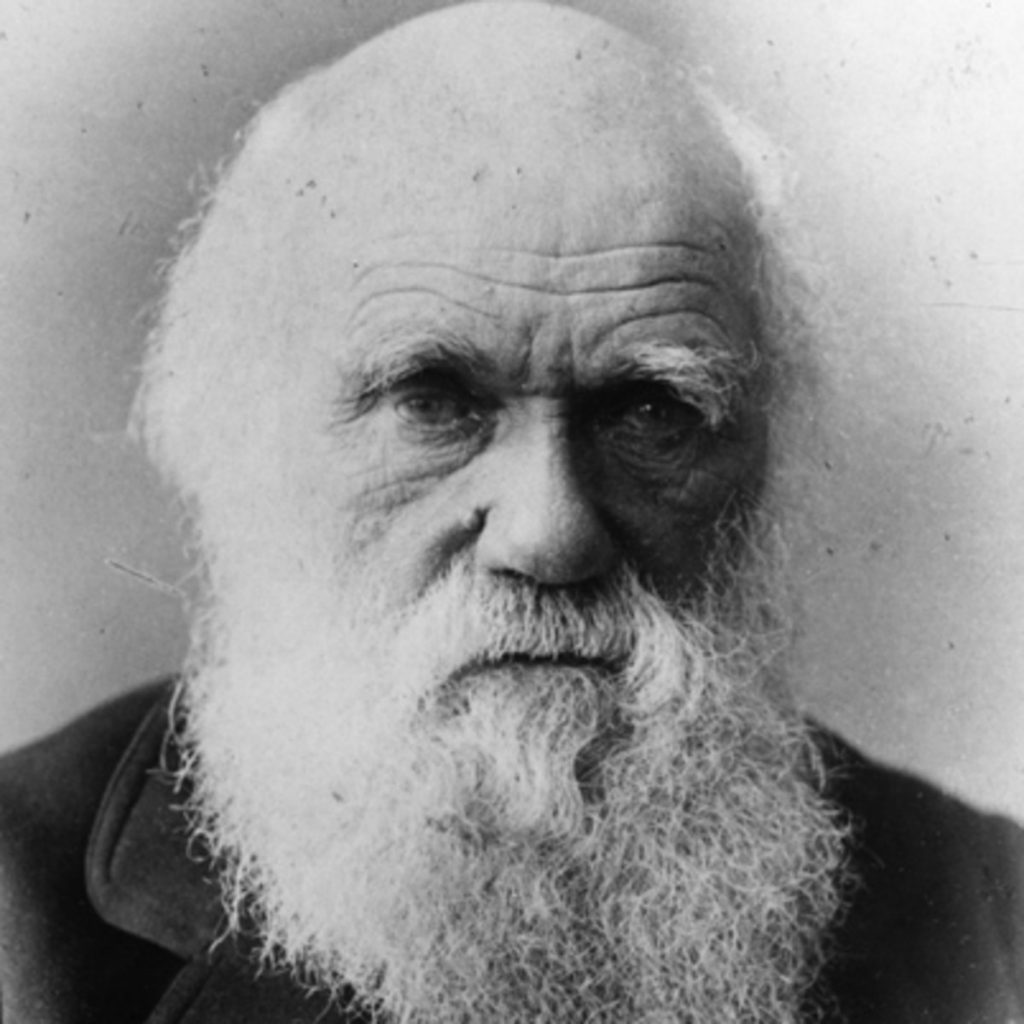
Over 150 years ago, essentially during the dark ages of biology, Darwin wrote his theory regarding common ancestry and descent of all animals. He concluded this with the naked eye–no need of a microscope. He simply observed nature and diversity, called the mechanism Natural Selection and Spontaneous Mutation, surprisingly in much the same way science stubbornly continues to adhere to his theory despite the mountains of evidence to the contrary.1 Darwin did not use a microscope to propose his theory and modern evolution proponents today equally seem to rather leave the microscope out as well.
Regardless, much of what Darwin observed with the naked eye, was later learned to have occurred by the genetic function of DNA code. Of course Darwin could not have known these facts, which was due to no fault of his own, but how can modern scientists (with nano-scale microscopes) adhere to Darwin’s antiquated theory? and Why?
In the last 20 years, with massively more detailed equipment, techniques, computers, and microscopes, scientists are learning of the truths of genetic function at rapid rates. The evidence is creating massive problems for Darwin’s ambitious theory.
Professor of biochemistry at Lehigh University, Michael Behe describes in his magnificent book, Darwin Devolves that he has experimentally and through genetic computer models has identified mechanistic problems associated with Darwinian evolution. Namely that spontaneous mutations cannot account for diversity beyond basic species level, and certainly not reaching even into the family level. Behe identifies through research that the strength of natural selection (DNA genetics as discussed above in detail) to “lock in” changes (surprisingly) can cause characteristics to appear quickly. Such as beneficial changes in Brazilian Cichlid fish coloration and size, beak size in Galapagos finches, or digestive adaptions in bacteria.1
Unfortunately, such spontaneous mutational changes are completed by a genetically degradative process netting a loss of information or function to the organism.1 Examples of such “beneficial” changes include an amino acid “letter” error, spontaneous duplication of an amino acid segment, or an outright deletion of genetic material.1 In each case, there was never an increase in information but always a loss or degradative effect on genetic material.1 A devolution. Therefore, as Behe notes, “counterintuitively”, these losses of genetic material and function caused by errors of spontaneous mutation were shown (in rare cases) to be beneficial to the organism.1 (emphasis mine).
How could degrading the genetic material account for a beneficial result?

As an analogy, imagine you are on a doomed flight–and due to human error you are informed by the pilot that the plane was never refueled and therefore is now very low on fuel. The plane will not reach its destination with the heavy cargo it currently holds. The pilot is referring your prized Lamborghini automobile! The pilot explains the grave circumstances that even if everyone parachutes out, the car will not survive impact. The pilot states that frankly, if the car is not dropped everyone on board will die. Therefore, the car is dropped, the weight of the plane is reduced, fuel is conserved and the plane safely lands. The analogy shows that dropping the car was a beneficial process for survival. But obviously, this happened at a vast expense. Your once useful and valuable car is gone. Perhaps you have insurance that will replace the car with another, but this is not the case for molecular machines. In living organisms, once the mutation (loss) occurs it cannot be undone, repaired, or replaced. It is a function that is forever gone.
Why is it so rare (and difficult) for Spontaneous Mutations to form new cellular functions in the cell?
Michael Behe and his colleague Dave Snokes (from the University of Pittsburgh) sought to build the simplest multi-residue for simplicity called a hook and latch using Darwin’s mechanism of spontaneous mutation. Behe called the multi-residue the simplest mini-Irreducible Complex structure or a “mIC”. The mIC analogy is the hook and latch used to hold a protein chain as to be completed later for a different formation of binding. In other words, the absolute simplest molecular change (“evolution”) as to change the function of an organism. As an analogy imagine the simple hook and hole shape of a basic shed door lock. However, the task as modifying a mere two amino acids proved to be a quantum leap and extreme mathematical difficulty for Darwin’s mechanism. Even while using very liberal starting assumptions regarding the two amino acid modification, first analysis found it would take a million organisms 100 million years to attain such a feat. Behe and Snokes estimates a more conservative estimate was more like a million organisms would take a billion year to attain the feat. This was largely due to the rate of spontaneous mutations that caused harm were much greater than the few that might benefit the organism.1 (see illustration below)
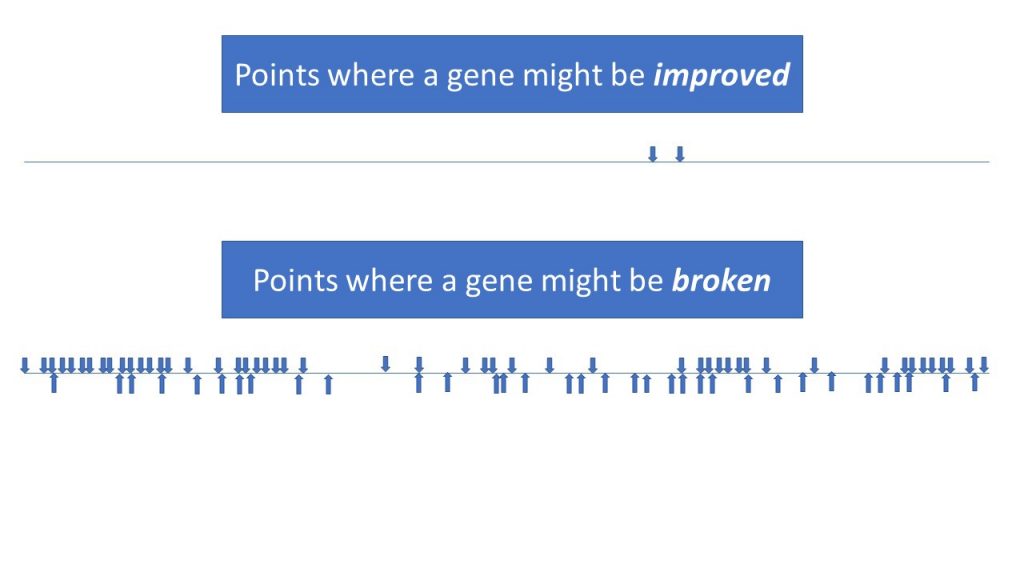
Based on chart in Darwin Devolves, The new science about DNA that challenges Evolution, Michael Behe
Therefore, excluding the possibilities of pure imagination, science fiction, or mathematical acrobatic miracles, the two amino acid modification was “an insurmountable problem for undirected evolution but not because of the amount of time involved…(but) rather because damaging a gene only requires a single hit, and it is the ratio of times that is crucial”.1 Simply put, the multitude of damaging mutations hit like flashes of lightening compared to the rare chances the correct position is hit– causing the protein to break well before any mIC could be completed.1
Such poison-pill mutations will always dominate a Darwinian evolutionary landscape…such grand claims for Darwinism explaining molecular life is like claiming “an illiterate wrote Romeo and Juliet.”
“Darwin Devolves” Michael Behe p.242
Applying the Principle of Comparative Difficulty, if a simple problem cannot be completed then the more complex one is impossible.
Here, even the “crummy two-amino-acid-residue disulfide bond”, the simplest receptor for protein change in an organism, is very troublesome.1 Therefore, it is ludicrous to assume the same process could create massively elegant and complex molecule systems and machinery.
If the mechanism for changing (clearly not even close to forming) even two amino acids in one protein of just over 350 letters in length, using clean variables within computer modeling, then how can anyone pretend that this mechanism can account for the vast diversity or life?
If such bizarre claims were shouted by someone dressed as Napoleon in the town square they would be ridiculed, laughed at, and likely arrested.
However, this nonsense is, often belligerently, exclaimed by some of “the world’s most intelligent scientists showing that craziness is not all confined to the clinically insane.”
“Darwin Devolves” Michael Behe
As we discussed at the beginning of this article, Darwin’s theory and namely the term “evolution” is now used to explain everything. It is naturalism without cause, purpose, design, or therefore mind. We discussed that evolution is relied upon to explain the origin of matter and life plus everything in between such as the universe, stars, galaxies, planets, moons, comets, and really—everything else. It even has even been touted as an explanation for, “politics, the law, literature, music, love— and even the mind itself (or more accurately, despite the idiocy, the lack thereof).
(Evolution) accounts for all this, “it just has trouble accounting for a disulfide bond.”
“Darwin Devolves” Michael Behe
In conclusion, Darwinian evolution, the positive changes and diversity we all observe and rightly find ourselves in awe of, is driven by DNA genetic function. The same function evolution chiefly calls Natural Selection. However, evidence shows that reproduction cannot be the mechanism to cause a change in animal classification such as being the mechanism to cause the formation of a new genus, family, order, class, phylum, or kingdom. We find that DNA allele (germ line) gets locked in by Natural Selection. While it ensures variety within species it cannot and does not provide a means to create new animal classifications. We found that Spontaneous Mutations (During DNA replication– not at reproduction) as a mechanism works by damaging, deleting, or breaking genes– degrading genetic material. As Michael Behe stated, such damages, in rare cases, can “counterintuitively” allow the survival of species. Finally, The Darwinian mechanism is largely (if not completely) Devolutionary because it works by promoting the rapid loss of genetic information spontaneously. The mechanism works chiefly by squandering genetic information for short term gain as to obtain a beneficial characteristic at a genetic cost which is forever irretrievable.1 A real life example of such a beneficial mutation is Sickle Cell.
1 “Darwin Devolves” The New Science About DNA that Challenges Evolution, by Michael Behe
2 https://www.ncbi.nlm.nih.gov/books/NBK21894/
3 https://hub.jhu.edu/2017/03/23/cancer-mutations-caused-by-random-dna-mistakes/

